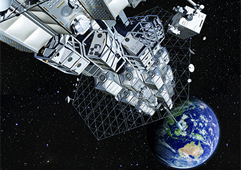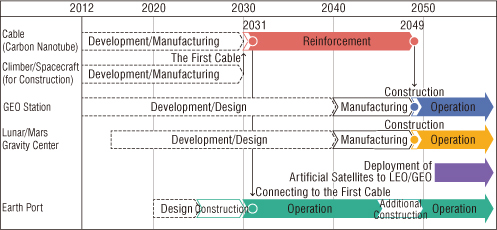The Space Elevator Construction Concept
-
Technologies
The space elevator is planned to be built by the year 2050
Obayashi pursues the potential for the future of the space elevator from a construction standpoint, and describes a newly-designed, whole-space elevator system, including its construction process, which we designed on the basis of work by construction engineers who completed the world's tallest free-standing tower, TOKYO SKYTREE®, in 2012.
In the following animation, a space elevator which climbs from the Earth Port as a departure port for people to Geostationary Earth Orbit Station at a height of 36,000 km is featured.
Image Animation
Explanation Animation
Concept Outline
The space elevator is planned to be built by the year 2050 with a capacity to carry 100-ton climbers. It is composed of a 96,000-km carbon nanotube cable, a 400-m diameter floating Earth Port and a 12,500-ton counter-weight. Other facilities include Martian/Lunar Gravity Centers, an Low Earth Orbit Gate, a Geostationary Earth Orbit Station, a Mars Gate and a Solar System Exploration Gate.

Geostationary Earth Orbit Station

Earth Port
The construction process consists of deploying the cable and constructing the facilities. It is necessary to analyze the cable dynamics in order to estimate the characteristics of the cable, counter-weight, facilities and climbers, and in order to determine the construction procedures. Parameters for the cable dynamics include tension, displacement and elongation of the cable due to ascending climbers, masses of counter-weight and cable, wind, and fixed loads of facilities. With the help of a computer simulation of the equations of motion, we designed the system and determined the construction process.
Based on the results, we conclude the following: construction will be technically feasible with an assumed cable tensile strength of 150 GPa, it will take roughly 20 years to construct the cable, the impacts of wind or Coriolis force on cable displacement are small, and it is essential to fix one end of the cable to the earth's surface, always applying pre-tension at the ground end. According to the plan, a 20-ton cable is deployed initially, and is reinforced 510 times by climbers up to 7,000 tons, ascending in succession over roughly 18 years. The facilities are then transported and constructed within one year.

Construction Schedule

Main Facility of Earth Port
The current technology levels are not yet sufficient to realize the concept, but our plan is realistic, and is a stepping stone toward the construction of the space elevator.

